关于城市双碳指数
About Carbon Peak & Carbon Neutrality Index
城市双碳指数由中国环境科学研究院与公众环境研究中心联合成立课题组共同开发,通过对城市碳排放量、排放趋势、政策变化等内容的追踪收集,并依据课题组设定的评价体系权重,对全国GDP总量高于1000亿元人民币、人均GDP超过8,000美元(约5.5万元人民币)、城镇常住人口大于30万的城市,进行双碳指数的评定。
The 2021-2022 Carbon Peak & Carbon Neutrality Index was developed by a joint research group of the Chinese Research Academy of Environmental Sciences and the Institute of Public and Environmental Affairs. The Carbon Peak & Carbon Neutrality Index is developed by a research group jointly established by the Chinese Research Academy of Environmental Sciences and the Institute of Public and Environmental Affairs, which collects information on carbon emissions, emission trends, and policy changes in cities, and assesses cities with a total GDP of more than 100 billion yuan, a per capita GDP of more than 8,000 U.S. dollars (about 55,000 yuan), and a resident population of more than 300,000 people, based on the weights of the evaluation system set up by the research group.
数据来源于《中国统计年鉴》《中国能源统计年鉴》《中国环境统计年鉴》,以及国家和各城市发布的国民经济和社会发展统计公报,各研究机构已公开发布的研究成果,有关政府部门官网公开信息和报道,共采集了全国110个城市截至2023年6月30日的相关数据。
The data comes from the “China Statistical Year Book”, “China Energy Statistical Year Book”, and “China Statistical Yearbook on Environment”, as well as the national economic and social development statistical bulletins released by the state and cities, the research results released by research institutes, and the data of the Dual Carbon Index. As of June 30, 2023, the data of 110 cities in China have been collected from the national and city statistical bulletins on national economic and social development, the research results published by various research institutes, and the public information and reports on the official websites of relevant government departments.
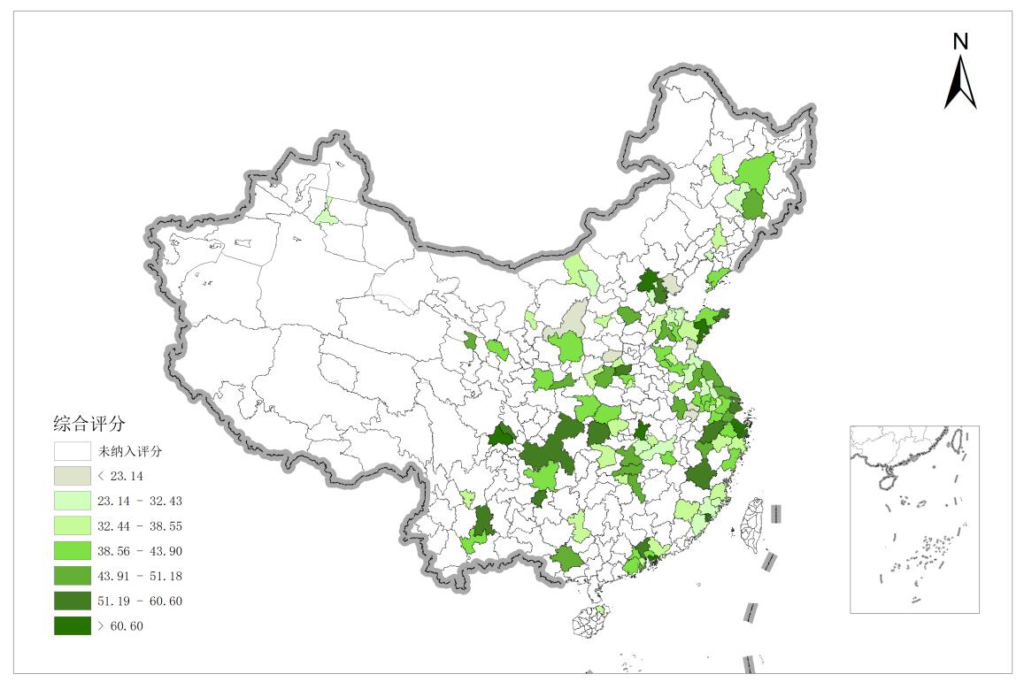
来源:《中国城市双碳指数2021-2022》
Source: 2021-2022 Chinese Cities Carbon Peak & Carbon Neutrality Index Report
城市双碳指数指标体系
Carbon Peak & Carbon Neutrality Index Indicator System
该体系共设立三个层级的指标,其中一级指标包括气候雄心、低碳状态和排放趋势;二级指标包括宏观目标、能力建设、能源消费、经济社会结构和排放水平;三级指标包括碳达峰目标、碳中和相关目标、试点示范建设、统计核算披露、节能环保投入占比等,详见下图。
The system has three levels of indicators as below:
Level 1 indicators: climate ambition, low carbon status, and emission trends.
Level 2 indicators: macro targets, capacity building, energy consumption, economic and social structure, emission levels.
Level 3 indicators: carbon peak targets, carbon neutrality-related targets, pilot demonstration constructions, disclosure of statistical accounting, energy conservation, and environmental protection investment ratios, etc., as shown in the figure below.
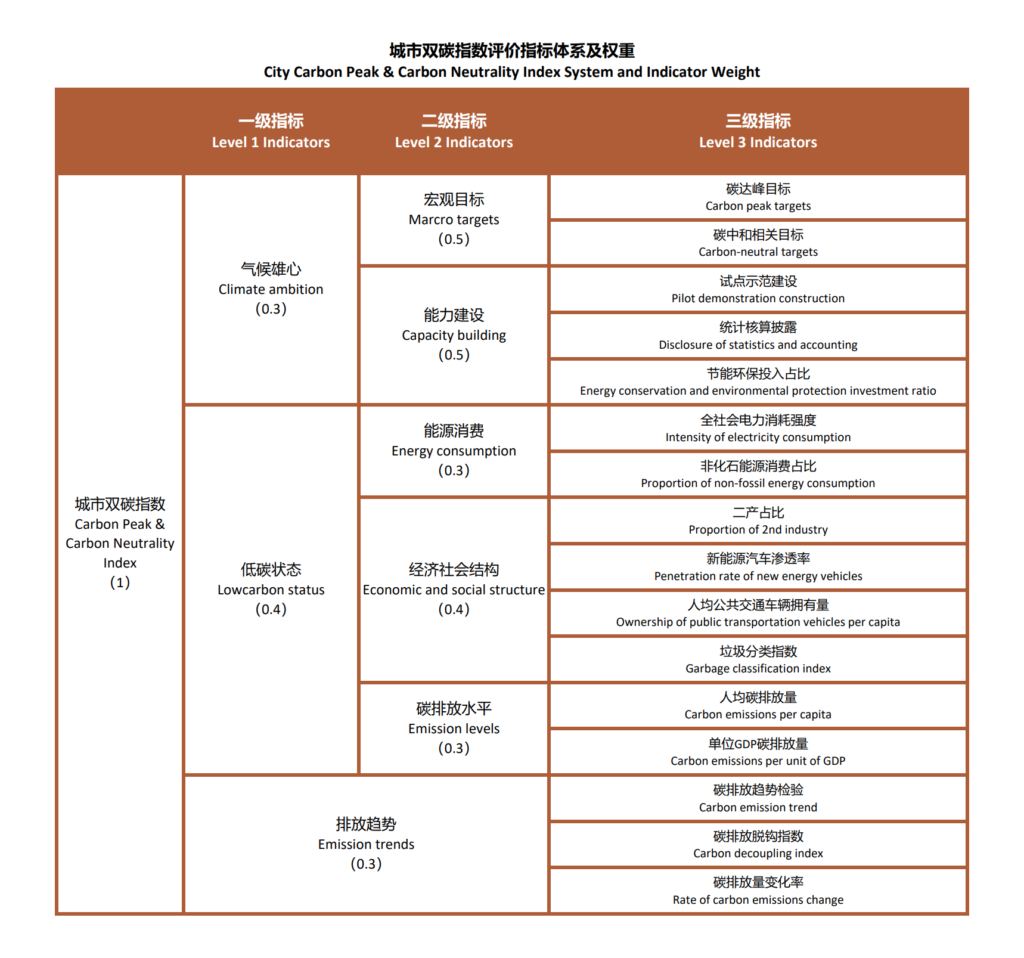
来源:《中国城市双碳指数2021-2022》
Source: 2021-2022 Chinese Cities Carbon Peak & Carbon Neutrality Index Report
总体趋势
Overall Trend
《报告》评价结果显示2021-2022年度的中国城市双碳指数,深圳排名第一,成都、青岛进入前三,北京、宁波、武汉、厦门、昆明、上海、广州入围前十。 宁波、盐城、江门、威海等城市得分明显上升,连云港、温州等城市得分明显下降。 榆林、马鞍山、日照、芜湖、晋城等城市排名靠后。
The evaluation results of the Report show that for the Carbon Peak & Carbon Neutrality Index 2021-2022, Shenzhen ranked first, Chengdu and Qingdao entered the top three, and Beijing, Ningbo, Wuhan, Xiamen, Kunming, Shanghai and Guangzhou were among the top ten. The scores of Ningbo, Yancheng, Jiangmen, and Weihai have increased significantly, while the scores of Lianyungang and Wenzhou have dropped significantly. Cities such as Yulin, Maanshan, Rizhao, Wuhu, and Jincheng ranked low.
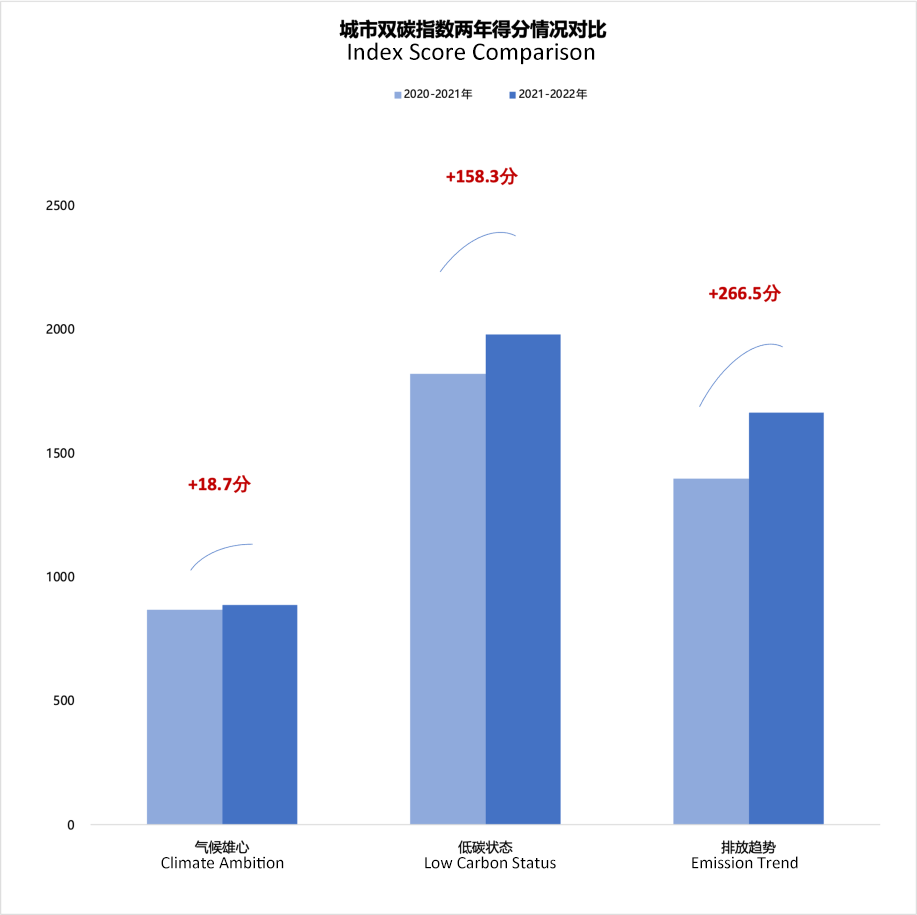
来源:《中国城市双碳指数2021-2022》
Source: 2021-2022 Chinese Cities Carbon Peak & Carbon Neutrality Index Report
目前,中国城市碳排放量占全国总排放量的85%,显著高于全球平均水平的71%-76%。城市碳排放水平的控制和降低是中国通往碳中和之路上的关键。根据《报告》结果来看,110个城市的总得分对比上年有所增长,但却有42个城市的的分出现了下滑,考虑到疫情后复工复产的影响,得分结果呈现出来的大趋势,说明了在中央政府提出双碳战略后,中国的碳中和总体环境正在变好。
Currently, China’s urban carbon emissions account for 85% of the country’s total emissions, significantly higher than the global average of 71%-76%. Controlling and reducing the level of urban carbon emissions is key on China’s road to carbon neutrality. According to the results of the report, the total score of 110 cities has increased compared to the previous year, but 42 cities’ scores have declined. Taking into account the impact of the resumption of work and production after the epidemic, the general trend of the score results shows that China’s overall environment for carbon neutrality is changing for the better after the central government put forward the dual-carbon strategy.

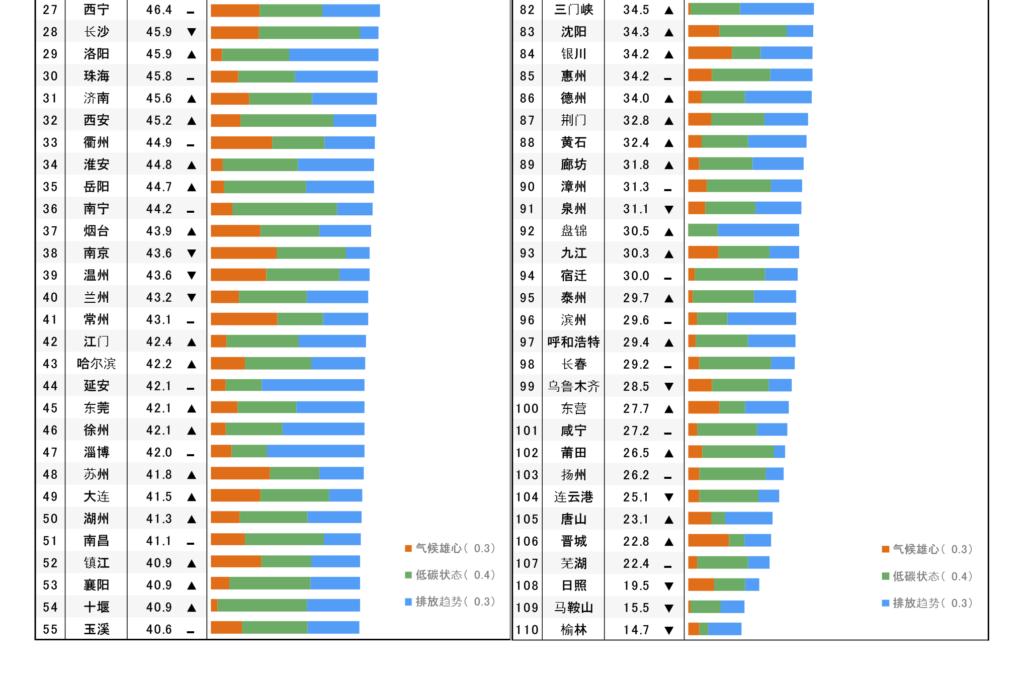
来源:《中国城市双碳指数2021-2022》
Source: 2021-2022 Chinese Cities Carbon Peak & Carbon Neutrality Index Report
数据亮点
Highlights
《报告》中的数据亮点主要由四个部分组成:
The highlights in the Report are as below:
⦁ 分布式光伏发展加速,支撑东中部能源转型
Development of distributed PV accelerates, supporting energy transition in East and Central China
2022年全国分布式光伏新增装机5,111万千瓦,占当年新增装机的58%以上,连续两年超过集中式光伏。分布式光伏建设正在有河北、河南、山东等地向浙江、江苏、广东等东部沿海地区扩展。110个城市非化石能源消费占比,从2019年的均值13.5%提高到2020年的14.7%,两年平均增幅9%,远高于全国平均3.9%的增幅水平。
In 2022, 51.11 million kilowatts of distributed PV installed nationwide, accounting for more than 58% of the new installations, exceeded centralized PV in the previous 2 years. Distributed PV products are now expanding to new markets from Hebei, Henan, and Shandong to Zhejiang, Jiangsu, Guangdong, and other eastern coastal areas. In this report, the average non-fossil energy consumption ratio rose from 13.5% in 2019 to 14.7% in 2020. The average increase rate is 9%, much higher than the national average of 3.9%.
⦁ 新能源汽车渗透率极大提高,提前完成“十四五”目标
The penetration rate of new energy vehicles has increased greatly, completing the “14th Five-Year Plan” target ahead of schedule.
2022年全国新能源汽车全年销量累计524.9万台,乘用车市场增速达到85%,渗透率达25.5%,提前达到国家“十四五”20%的目标值。
In 2022, the annual sales volume of new energy vehicles in China will total 5.249 million units, the growth rate of the passenger car market will reach 85%, and the penetration rate will reach 25.5%, which has reached the target of the 14th Five-Year Plan ahead of schedule.
⦁ 110个参评城市减排趋势优于全国平均水平
The emission reduction trend of the 110 cities in this report is better than the national average.
2020年,参评城市碳排放强度对比2015年平均下降21.7%,优于全国平均18.7%的下降幅度,基本达到了领头城市带动周边县市的目标。
In 2020, the carbon emission intensity of the 110 cities dropped by 21.7% compared with figures from 2015 and is better than the national average of 18.7%.
⦁ 部分城市的碳排放与经济增长呈脱钩趋势
Carbon emissions and economic growth are decoupled in some cities
参评城市中的资源型、工业型城市受限于能源结构与重工业结构,一定程度上发展趋缓,但在减排趋势上均有较为突出的表现。在“十三五”期间,参评城市的平均碳排放增速率为0.58%,其中包括大庆、淄博、延安等转型城市的碳排放呈下降趋势,年均降幅约5%。其中,43%的城市碳排放与经济增长呈强脱钩,31%的城市呈弱脱钩。
Resource-based and industrialized cities have slowed down economic development due to the energy and heavy industry structures, but all of them have outstanding performance in terms of emission reduction trends. During the 13th Five-Year Plan period, the average carbon emission growth rate of the participating cities was only 0.58%, including Daqing, Zibo, Yan’an, and other cities in the energy transition process. The carbon emissions showed a downward trend, with an average annual decrease of about 5%. Among all 110 cities, 43% of them showed a strong decoupling of carbon emissions from economic growth, and 31% showed a weak decoupling trend.

来源:《中国城市双碳指数2021-2022》
Source: 2021-2022 Chinese Cities Carbon Peak & Carbon Neutrality Index Report
主要挑战
Key Challenges
尽管数据显示中国的碳中和大趋势向好,但仍有数个挑战需要应对:
Although the general trend of carbon neutrality in China is positive, the report findings show that there are still several challenges that need to be addressed:
⦁ 降碳与大气污染治理需要更好协调
Carbon reduction and air pollution control need to be better coordinated
数据显示以PM2.5为主的城市大气污染,与城市碳排放强度呈现高度的一致性,降低碳排放工作应与大气污染治理工作的联动势在必行。当前我国产业结构偏重、能源结构偏煤、运输结构偏公路的基本情况尚未改变,需要替考双碳战略来驱动调整。
Data shows that urban air pollution, mainly PM2.5, is highly consistent with the intensity of carbon emissions, and efforts to reduce carbon emissions must be linked to air pollution control. At present, the basic situation of China’s industrial, energy, and transportation structure is not able to change in the short term, and it will need the dual carbon strategy as the main force to drive the changes.
⦁ 城市的碳达峰目标和双碳行动路径待明确
Carbon Peaking Targets and Dual Carbon Action Paths for cities are not clear
多数城市碳达峰目标尚未明确,碳中和目标也仅有2个城市正式对外公布。考虑到距中国的碳达峰目标仅剩不到7年的时间,尽快明确各城市的行动路径势在必行,刻不容缓。
Most cities have yet to announce their carbon peaking targets, and only two cities have formally announced their carbon neutrality targets. Considering that China has less than seven years to reach its carbon-peaking goal, it is imperative to formulate the action pathways of each city as soon as possible.
⦁ 碳排放占比偏高的工业大市表现欠佳
Major industrial cities with high carbon footprints
受到疫情影响导致的经济增长放缓,以及受地缘政治紧张导致的能源安全优先级提升等因素影响,参评城市中排放量前10个城市的排放总量占到了全部110个城市排放总量的30%。如何在当前多重因素影响的大环境下,保证经济发展和降低碳排放,将是长期存在的挑战。
As a result of the slowdown in economic growth due to the impact of the epidemic and the increased prioritization of energy security due to geopolitical tensions, the top 10 emitting cities account for 30% of the total emissions of all 110 cities. How to ensure economic development while still reducing carbon emissions under multiple factors will be a long-term challenge.
⦁ 碳排放数据披露制度不统一
Unharmonized data disclosure system for carbon emissions
全国各省市的能源统计信息和碳排放数据披露存在不统一和信息滞后的情况,不利于总体制定双碳路径,也对企业在能源方面的转型和未来投资落地信心造成了影响。
The inconsistency and lag in the disclosure of energy statistics and carbon emissions data in different provinces and cities across the country are not conducive to the overall development of the dual carbon pathway. The unclear data and policies will also hurt local companies with the need to perform energy transition, as well as attracting investment from outside.
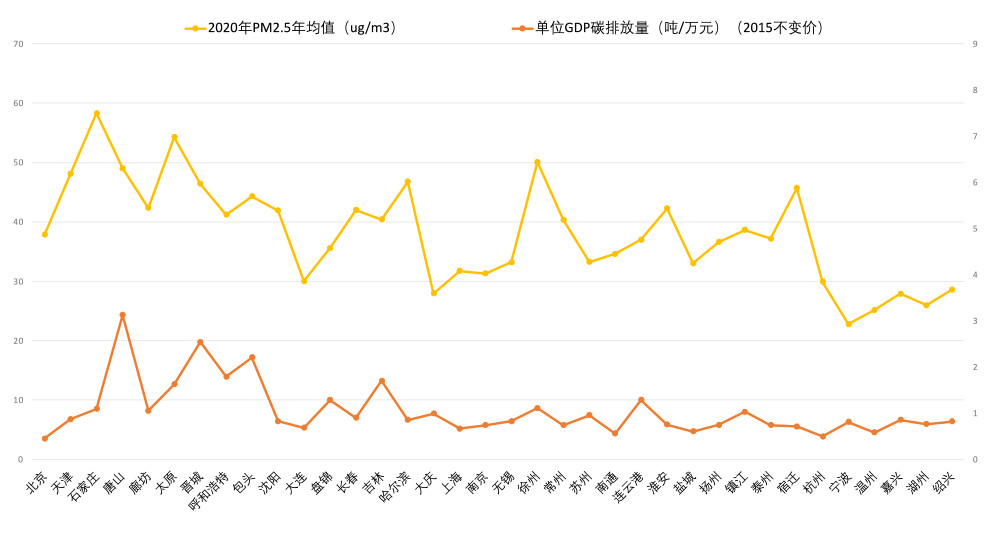
来源:《中国城市双碳指数2021-2022》
Source: 2021-2022 Chinese Cities Carbon Peak & Carbon Neutrality Index Report
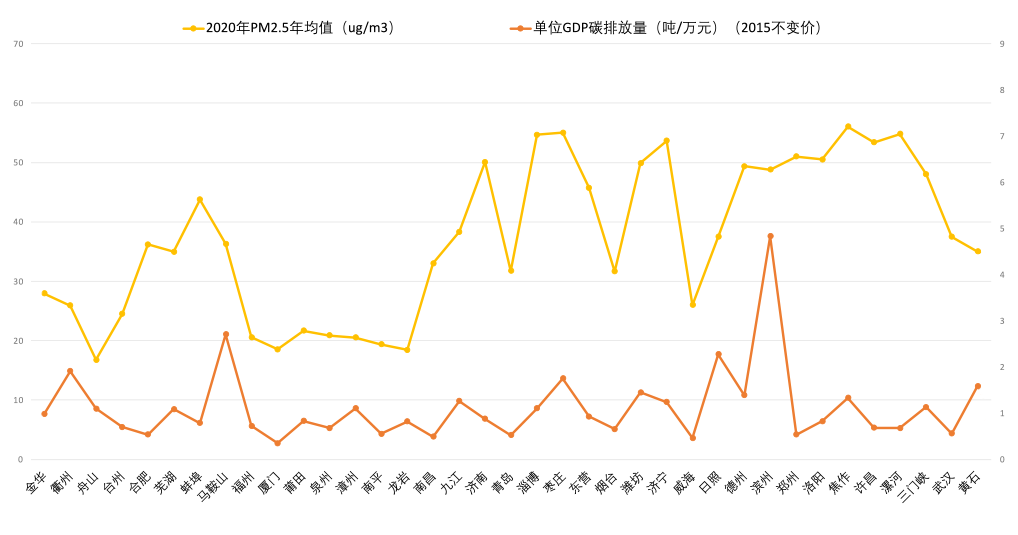
来源:《中国城市双碳指数2021-2022》
Source: 2021-2022 Chinese Cities Carbon Peak & Carbon Neutrality Index Report
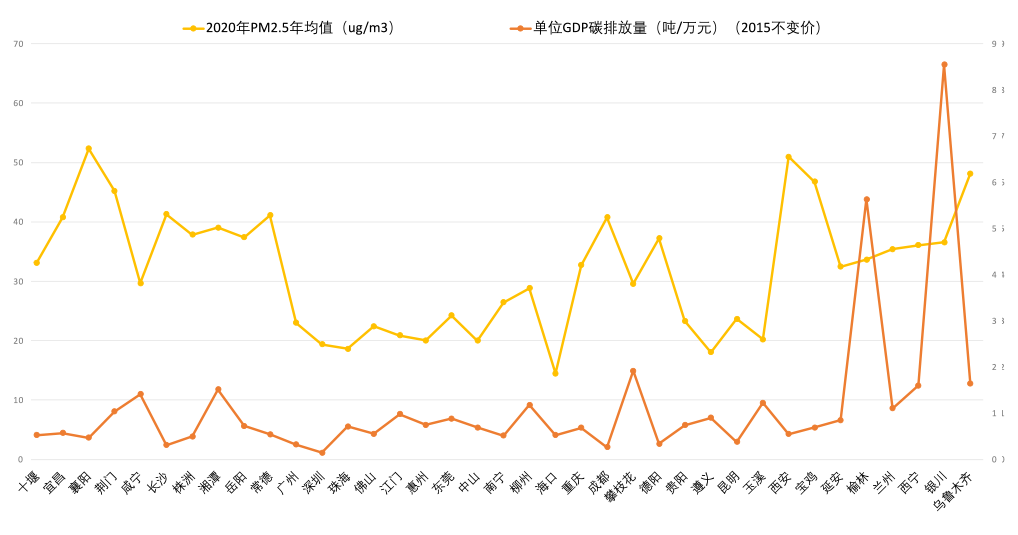
来源:《中国城市双碳指数2021-2022》
Source: 2021-2022 Chinese Cities Carbon Peak & Carbon Neutrality Index Report
在碳中和政策环境下共享来自全球的解决方案
Shared global solutions in the framework of the carbon neutrality policies
实现去碳化必须要成为全球共识,如此以来不同国家才能够为这个共同的目标而做出努力,克服在地缘政治紧张的局势下所面临的挑战。如果没有一个新的经济模式、新的范例、打破常规的思维模式和全面创新的解决方案,去碳化这一难题将永远无法被攻克。
Shared objectives towards decarbonization must become the common ground, so that, countries can act jointly in addressing the challenges despite potential geopolitical tensions. Because decarbonisation cannot be achieved without new economic models, paradigms, out-of-the-box thinking, holistic approaches and innovative solutions.
在实现去碳化这一目标的所驱使的转型过程中,工业和服务业都将为进入碳中和时代的欧洲和中国企业带来不可估量的上级。为了能够更好的抓住机遇,积极主动、协调一致地去克服通往碳中和道路上所遇到的困难,是不必可少的一环。在这条道路上,首当其冲的是来自能源和环保领域供应链上的参与方,而在整个环节中,必不可少的还有来自仲欧脱碳科技的战略思考:我们充分意识到,仅仅靠高精尖的科技、工艺技术是无法实现真正意义上的碳中和的,要将其创新地与各地区的实际情况相结合,因地制宜才能发挥最大的作用。
Driven by the transformation necessary to achieve decarbonisation goals, immeasurable business opportunities are opening up in all industrial and service sectors for European and Chinese companies who lead the way to a carbon neutral future. In this regard, everyone must play a proactive and coordinated role to overcome the decarbonisation challenge, first and foremost all actors along the energy and environmental protection supply chains. Last but not least, as also fundamental CNEUCN approach, we do recognize that cutting-edge technologies, processes and solutions must be paired with innovative and highly contextualised approaches: technologies alone will not achieve decarbonisation.
仲欧脱碳科技(CNEUCN)作为第一家落地中国的对碳中和相关活动提供全面解决方案的欧洲企业,目前已与欧洲和中国的顶尖学府和相关机构平台建立了长期的战略合作关系,并为这些机构和其他相关企业提供综合服务和技术支持。
China Europe Carbon Neutral Technology (CNEUCN) as the first European entity in China, able to tackle carbon neutrality-related activities holistically, has established long-term cooperation with top level Universities, in Europe and China, as well as with oriented associations and platforms to integrated services and technologies to individual entities and large-scale stakeholders which are facing these challenges.
阅读报告原文,请点击
Read full report via:
https://www.ipe.org.cn/reports/report_21940.html
如想了解更多信息和更多详情,请联系: [email protected]
For more information and further details please write to: [email protected]
仲欧脱碳科技有限公司中欧碳中和可持续城市发展平台项目将由为此项目成立的同名私营公司运营,旨在通过聚集各方优势,针对每一个课题制定出量身打造的解决方案,以全面和包容的工作方式为中国和欧洲的碳中和之路添砖加瓦。
仲欧脱碳科技 有限公司该平台将发挥积极和创新的作用,为实现碳中和所需的构想、塑造、设计和实现转型提供服务。
China Europe Carbon Neutral Technology aims to support and substantially contribute to China and Europe path towards carbon neutrality in a holistic and inclusive way by gathering all the stakeholders and creating solutions for each challenge.
China Europe Carbon Neutral Technology will play an active and innovative role in providing services to conceive, shape, design and accomplish the transitions needed to achieve carbon neutrality.
Cover pic:
